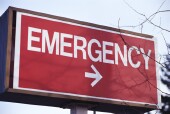- FDA Approves New Antibiotic Against UTIs
- New School Lunch Rules Target Added Sugars, Salt
- Dairy Cows Moved Across State Lines Must Now Be Tested for Bird Flu
- TikTok Riddled With Misleading Info on Health: Study
- Emulsifier Chemicals Are Everywhere in Foods. Could They Raise Diabetes Risk?
- Opioids During Pregnancy May Not Raise Psychiatric Risks for Offspring
- Could Heartburn Meds Raise Your Migraine Risk?
- Drug, Alcohol Abuse Goes Untreated in Many Ex-Prisoners
- Watchdog Group Says U.S. Food Recalls Rose Again Last Year
- Genes Could Mix With Pesticide Exposure to Raise Parkinson’s Risk
Medicaid Use May Boost ER Visits, Study in Oregon Suggests


New research reveals that Oregon residents covered by Medicaid — the publicly funded health insurance program for the poor — are 40 percent more likely to use emergency rooms than people with no insurance.
This finding suggests that expansion of Medicaid, which some states are allowing under the Affordable Care Act, could lead to more use of emergency departments instead of less, researchers said.
“Although one always needs to be careful generalizing to other settings, these results suggest that other Medicaid expansions are unlikely to decrease emergency room use,” Amy Finkelstein, a professor of economics at Massachusetts Institute of Technology and a principal investigator of the study, said in a university news release.
“When you cover the uninsured, emergency room use goes up by a large magnitude,” Finkelstein noted. “In no case were we able to find any subpopulations, or type of conditions, for which Medicaid caused a significant decrease in emergency department use.”
The study, published Jan. 2 in the journal Science, revealed that people with Medicaid used the emergency room more for a variety of reasons, even for conditions that might be more easily treated in a doctor’s office.
For the study, the researchers tracked emergency department records of 25,000 Oregon residents over 18 months. Oregon expanded Medicaid in 2008 with the help of a lottery system that allowed 10,000 of 90,000 applicants to get coverage.
More information
For more about health insurance, see the U.S. National Library of Medicine.
Source: HealthDay
Copyright © 2024 HealthDay. All rights reserved.










